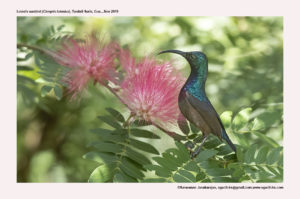
Loten’s Sunbird Cinnyris lotenius
Etymology:
- Cinnyris : Greek word kinnuris small bird mentioned by Hesychius
- Lotenius : Named after Dutch naturalist John Gideon Loten (1710–1789)
Vernacular Names: Ta: Then-chittu, Then-urichan, Mal: Tenkili, Vali tenkili, Sinh: Ran sutikka, Mar: Lotencha suryapakshi/ Shinjir
Distribution in India: Resident of West and South Indian Peninsula.
Description: Size 13 cm; wt. of male 8–11 g, wt. of female 7–8 g. The bill is long, heavy and deeply arched. The male has most of upperparts, throat and lesser and median upperwing-coverts as dark, glossed blue-green and purple, rest of upperwing is blackish-brown. The tail is blackish-brown to blackish with deep glossy blue wash. The breast is metallic purple, narrow dark crimson or maroon breastband, bright yellow pectoral tufts, rest of underparts are sooty brown. The iris are dark brown or reddish-brown; bill is black, mouth is pinkish-brown; legs are horn-black. The male in non-breeding plumage is like immature male. The female is dull dark brownish-olive above. The tail is blue-black, tipped and edged white; dull yellow below, vent and undertail-coverts are white. The juvenile is similar to female but greyer below has shorter bill with pale base, and softer feathers. The immature male is like the female, but has green shoulders and rump, and broad greenish-black patch from throat to upper breast. The race hindustanicus (South India South from North Maharashtra and Central Andhra Pradesh.) is smaller and shorter-billed than nominate, and female paler yellow below.
Habitat: It is found in deciduous woodland, open country with trees, cultivation and gardens, particularly around flowering trees and shrubs; occasionally in canopy of evergreen forest. It is found up to 1600 m.
Food habits: It eats Insects, spiders and nectar. It forages singly and in pairs, at various levels. It gleans items and hovers. It robs nectar from flowers by puncturing base of calyx.
Breeding habits: They nests in India in all months, mainly in Mar. The nest is a pouch, entrance with porch, made from fibres, lichens, rootlets, grass, moss, leaves, etc., lined with vegetable down or wool, exterior very untidy, covered with variety of different particles, often forming ragged “tail”, suspended above ground from twig or wedged among creepers or in bush in shady place, or in lined hollow in dense mass of cobwebs. They lay a clutch of 2–3 eggs.